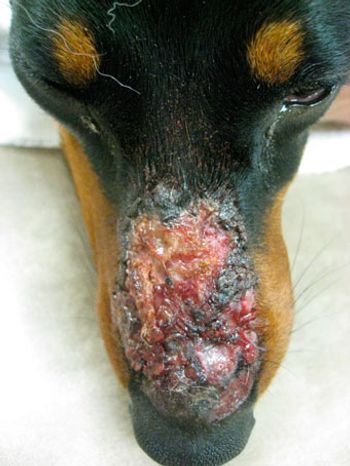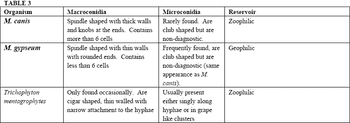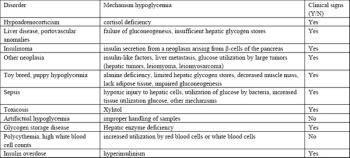
The eosinophilic granuloma complex (EGC) in the cat actually consists of three similar diseases. Despite the name, the three diseases do not always cause granulomas.

The eosinophilic granuloma complex (EGC) in the cat actually consists of three similar diseases. Despite the name, the three diseases do not always cause granulomas.

Most of the following options illustrate the various medical means of salvaging chronic otitis in a dog, However, the ideal option is to prevent acute otitis externa from becoming chronic.

Skin disorders in rabbits and rodents can manifest in the form of pruritus, alopecia without pruritus, scaling or nodules. Combinations of one or more of these clinical presentations may be observed in an individual.

The exact etiology in most clinical cases is not well understood. Food allergy is defined as an immunologically based reaction to food. Immunologic mechanisms of types I-IV have been hypothesized.

Any appointment for dermatology begins with the technician taking a through history of the disease. Important points to cover are the signalment (age, breed, sex), the presenting complaint (especially important to determine if pruritus is present), the age at onset and if the onset of the skin problem was sudden or slow, and if the disease is seasonal.

Atopic dermatitis is the arguably the second most frequent allergy in dogs (after fleas) and the third most frequent allergy (after fleas and food) in cats. There is a strong genetic tendency in dogs, with golden retrievers, Labrador retrievers, terriers, Dalmatians, and Shar-peis among the predisposed breeds.

Canine demodicosis is a noncontagious parasitic skin disease caused by an overpopulation of the host-specific follicular mites of the genus Demodex. Most cases of canine demodicosis are caused by Demodex canis, although two other species of demodicid mites are reported.

Seasonal pruritus (due to fleas or pollen allergies) typically is more pronounced in the warm weather, whereas allergy due to dust or mold components may be more severe in the winter.

What's the most likely diagnosis in this dog?

Dr. Thomas Lewis discusses this irritating dermatologic disease.

Alert the President! Study calls into question claims that some dogs are allergen-free

This condition affects dogs of any age or breed, although German shepherds are predisposed. It affects the mucocutaneous junctions (MCJs) of the nose and lips most frequently, but other MCJs can also be affected. This is a surface bacterial infection (usually S. pseudintermedius) wherein there is a "standoff" between the bacteria and the immune system at the MCJ.

In the field of veterinary medicine we see a constant search for newer, more effective, and convenient but inexpensive drugs with lesser side effects. Not only new drugs are interesting, but old drugs are occasionally rediscovered for new indications.

Bacterial pyoderma is more common in the dog than any other mammalian species. Currently Staphylococcus virulence factors such as protein A, leukocidin, hemolysins, epidermolytic toxin have not been shown to be to play a role in canine pyoderma as opposed to humans with Staphylococcus aureus infections.

PF is the most common immune-mediated skin disease of the cat. It often begins on the face and pinnae, but also usually involves the foot pads and claw beds. Crusts and pustules on the face and pinnae, hyperkeratotic footpads, a purulent to caseous discharge with crusting around the nail beds, and crusting of the nipples are all common findings.

Vasculitis is characterized by an aberrant immune response directed toward blood vessels. Histologically there is an inflammatory response involving and destroying blood vessels leading to ischemic changes (see histopathology). A vasculopathy is a disease process in which tissue changes are consistent with ischemia but histologically vasculitis can't be identified.

The skin is the largest organ of the body and, in the view of many practitioners, it often accounts for the largest number of headaches. One would expect that since the skin is so easy to visualize, a diagnosis should be an easy task when compared with other, more hidden body organs. The problem is that many skin conditions have the same clinical presentation.

Itraconazole (Sporonax ?-Janssen Pharmaceuticals- 100 capsules and 10 mg/ml oral solution)) is a member of the azole family of antifungal agents. Imidazoles (Imidazole family (thiabendazole, clotrimazole, ketaconazole, miconazole and enilconazole) and triazoles (itraconazole and fluconazole) make up this family of drugs.

Zinc responsive dermatosis is a nutritional skin disease that can be categorized as syndromes I or II. Syndrome I is a disease primarily seen in Siberian huskies and Malamutes. Lesions develop in these breeds despite having adequate zinc in their diets and most commonly occur in young dogs (1-3 years of age).

Protocols are useful in helping to diagnose and treated many different disorders. Part of any good protocol should be a minimum data base (MDB). In addition to signalment, history, etc in veterinary dermatology laboratory testing should be a component of this data base.

In the normal dog fasting does not usually result in hypoglycemia. Therefore a serum glucose concentration < 60 mg/dl is almost always due to either organic disease or to laboratory error. In an animal with normal glucose homeostasis, insulin secretion is stimulated when the blood glucose is > 110 mg/dl; insulin secretion is depressed and secretion of hormones that oppose insulin (epinephrine, glucagon, cortisol, growth hormone) is stimulated when the blood glucose falls below < 60 mg/dl.

It is important to understand that ear disease is only a symptom (no more specific than "pruritus"). As Dr Flemming Kristensen stated "A patient showing ear problems is a dermatology case until proven otherwise". It is appropriate therefore to approach the diagnosis of ear disease just as you would for any other skin disease.

Behavior and medicine (or physiology) are not mutually exclusive; there is a complex interaction between the two. Studies published recently in the British Journal of Dermatology concluded that human patients subjected to brief psychological stress (PS) developed an increase in Psoriasis Area and Severity Index (PASI) and itch 4 weeks later(Verhoeven, 2009).

Topical therapy is an important symptomatic and complimentary treatment option in the management of various skin diseases. Canine skin is often more sensitive than is human skin due to anatomical and physiological differences, including differences in the thickness of the stratum corneum, skin pH and hair follicle density which can facilitate cutaneous penetration of active ingredients.

Once you have finished interviewing the witnesses, the next step is to collect the evidence. A minimum database ("derm–due-diligence") for any pruritic pet should include skin scrapings, close examination for external parasites (fleas, ticks, and lice), acetate tape tests, cytology and possibly coat brushings.